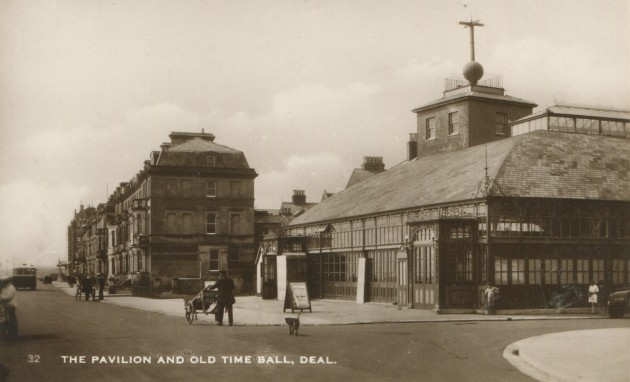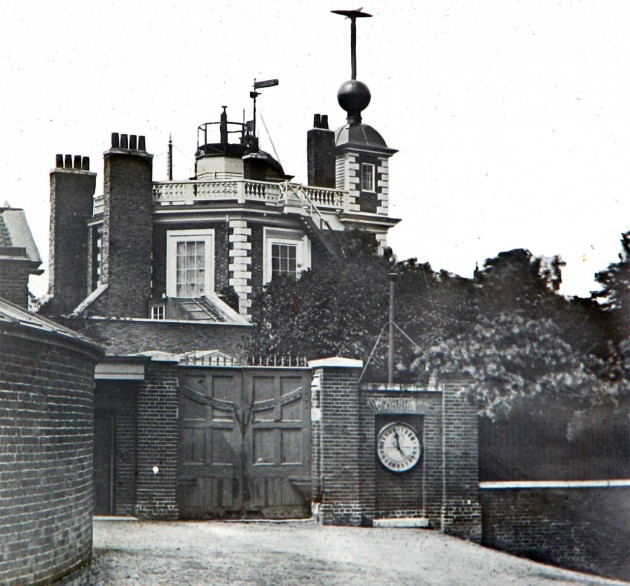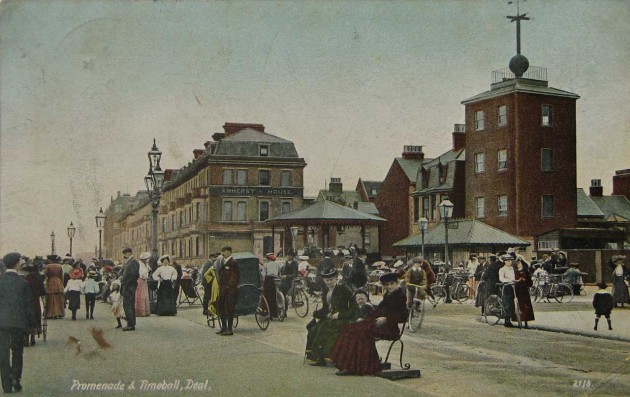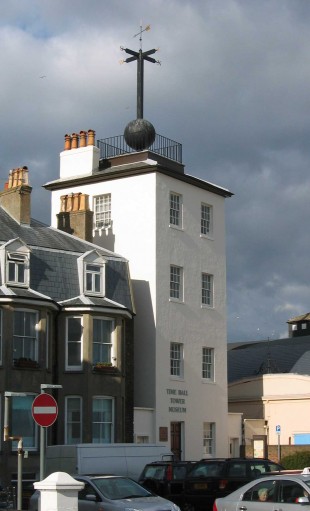The Royal Observatory Greenwich
…where east meets west
- Home
- Brief History
- The Greenwich Meridian
- Greenwich
(1675–1958) - Herstmonceux
(1948–1990) - Cambridge
(1990–1998) - Outstations (1822–1971)…
- – Chingford (1822–1924)
- – Deal
(1864–1927) - – Abinger
(1923–1957) - – Bristol & Bradford on Avon
(1939–1948) - – Bath
(1939–1949) - – Hartland
(1955–1967) - – Cape of Good Hope
(1959–1971)
- Administration…
- – Funding
- – Governance
- – Inventories
- – Pay
- – Regulations
- – Royal Warrants
- Contemporary Accounts
- People
- Publications
- Science
- Technology
- Telescopes
- Chronometers
- Clocks & Time
- Board of Longitude
- Libraries & Archives
- Visit
- Search
The Deal Time Ball (1864-1927)
In the 1850s, a Time Ball was set up in the costal town of Deal to provide visual time signals for nearby shipping in the English Channel. It was administered by the Royal Observatory from 1864 until 1927 when it became obsolete and its operation was ceased. The Time Ball Tower currently operates as a museum under the care of the Deal Museum Trust (click here for more information).
Location
Deal has a long maritime history. It occupies a strategic position on the edge of the English Channel not far from Dover. Offshore, the notorious Goodwin Sands have claimed many a ship but the stretch of water known as the Downs, between the Sands and the town, provides a naturally sheltered anchorage. Deal has no harbour, but at one time was recorded as the third busiest port in England. A storehouse erected in the seventeenth century, expanded into a full blown Naval Yard covering an area of nearly 5 acres. It was at its busiest during the Napoleonic Wars (1803-1815), after which it went into decline. It was on the former semaphore tower, that the Time Ball was erected.
A new means of time distribution
The use of Time Balls to disseminate Greenwich Time began in Portsmouth in 1829. A few years later, in 1833, the Astronomer Royal, John Pond, set up a Time Ball at the Royal Observatory in Greenwich. In 1849, Charles Shepherd patented a new form of electric clock whose potential prompted Pond’s successor, George Airy, to enter discussions with Charles Walker of the South Eastern Railway Company with a view to distributing Greenwich Time more widely via the railway telegraph network.
In 1851 the Great Exhibition was held in Hyde Park in London. It was there, on 23 May and again on 24 June that Airy was able to see for himself, the electric 'master-and-slave' clock system installed by Shepherd for disseminating time to the exhibition’s numerous visitors. It consisted of a 'master clock' sending regular electrical (galvanic) impulses to a number of ancillary 'slave' dials. Airy, placed an order in December 1851 and by the following summer had a working system in place at Greenwich. It was to be at the heart of Britain’s time distribution system for the next 70 years.
By 1853, the Observatory’s master clock was controlling a public clock at its gates, three other clocks within the Observatory (including one in the chronometer room), and a clock at the London-bridge Terminus of the South-Eastern Railway. It also sent galvanic signals every day along all the principal railways diverging from London as well as dropping the Time Ball at Greenwich and another on the Offices of the Eastern Telegraph Company in the Strand.
A Time Ball for Deal
In early 1852, after the order with Shepherd had been placed, but before installation work at Greenwich had started, Walker asked Airy if he had considered sending a signal from Greenwich to drop a Time Ball at Dover. Then in April 1852, Commander Thomas Baldock wrote to the Admiralty suggesting that a Time Ball triggered from Greenwich should be placed on one of the South Foreland lighthouses for use of those ships in the Downs. The Admiralty took action and asked Airy to oversee the installation of a Time Ball at the Naval Yard in Deal.
Airy reported the news to the Visitors, in June 1853, adding: ‘Probably there is no roadstead in the world in which knowledge of true time is so important.’ A galvanic clock and Ball apparatus was ordered from Shepherd in November 1853. The Time Ball itself was made by Maudslay, Sons and Field, who had previously made the one at Greenwich. It was installed on the top of the former semaphore tower (built in 1821), becoming operational at the start of 1855.
Mode of operation
Like the Ball at Greenwich, the Deal Ball was painted black. It also operated in a similar way. It started to rise at 12.55 Greenwich Mean Time, stopping halfway up the mast. At 12.57, it rose to the top, before dropping at 13.00 precisely – the moment of one o’clock being signified by the start of the drop. An automated return signal was then sent from Deal back to Greenwich to indicate whether or not the Ball had dropped on time.
If the Ball failed to drop properly, it would be kept for 10 minutes at the halfway point then lowered gradually and dropped again by hand at 14.00, but with a lower guarantee as to its accuracy.
The timings given above are those published in The Admiralty list of Time Signals in 1880 and 1898. They are slightly different to the timings given for Greenwich, where the Ball began its final ascent some 30 seconds later. It is not known why this discrepancy existed. Today the Greenwich Ball begins its final ascent at 12.58.
A transfer of responsibility
When the Naval Yard was deemed surplus to requirements and sold off by the Admiralty in July 1864, the Time Ball Tower was excluded from the sale. There no longer being a competent resident authority for its superintendance, it was placed under the care of the Astronomer Royal and W. Newby appointed as time ball attendant. His son who acted as an assistant resigned in 1881 and was replace by J.G. Hayward. When Newby senior retired in 1892, it was Hayward who replaced him as time ball attendant. Hayward remained in post until 1904 when he died. His replacement was J. Jermyn who appears to have been in post until at least 1921. With the advent of reliable radio time signals the Deal Time Ball became obsolete and was closed down on 25 February 1927. It was put up for sale by auction with conditions attached to its future use. Having subsequently been used as a Tourist Information Centre, the Time Ball Tower has been run as a museum since Easter 2004, with the Ball dropping hourly from 09.00 to 17.00. Disaster struck on 18 August 2010, when a steel belt holding the ball in place above the tower snapped, causing the Ball, (a fibreglass replacement) to crash down onto the roof.

Taken in about 1930, this photograph shows the Time Ball only a year or so after it had been decommissioned. The building on the right is The Pavilion. Originally opened on 28 July 1928 as a theatre, it was substantially altered and re-opened as The Regent Cinema on 13 July 1933. From a postcard published anonymously
Problems in bad weather
In high winds, it was not possible to raise the ball for fear of damage. But the wind was not the only problem. The Time Ball was also vulnerable to ice forming on the mast, or snow accumulating on top of the ball. In early 1855, during its first weeks of operation, the weather was exceptionally cold and the drop failed for a variety of reasons, including the fact that the sulphuric acid in the batteries which powered the system turned to Jelly, causing them to stop working.
Teething problems in the early years
With the introduction of the galvanic apparatus in 1852, a connection between the Observatory and the railway telegraph system was required. Initially, the wires were routed underground through Greenwich Park, then across Blackheath to Lewisham Station. As the crow flies, the Time Ball at Deal was just over 60 miles from the Observatory. But due to the routing, the total length of the connection was about 100 miles.
The underground wires did not live up to expectation, largely due to problems with the insulation, which resulted in a reduction in signal strength or sometimes a complete loss of signal. In 1858 for example, the current arriving at Deal was so feeble over a period of months, that it was no longer possible to drop the ball automatically. The reduced signal was used instead as a guide for the attendant to drop the Ball (rather less accurately) by hand.
In August 1859, all four of the wires crossing Blackheath failed. On examination, it was found that the gutta percha insulation had perished along its complete length. This led to a rethink on Airy’s part, prompted in part by the success of a pair of telegraph wires that had been successfully strung across the park in 1853/4 from the roof of the Octagon Room to the observatory of the nearby Greenwich Hospital School (now the site of the National Maritime Museum car park). In 1860, a telegraph pole was erected on the Octagon Room roof to carry a new set of seven wires to connect with the railways via the top of a house in (King) George Street, four of them being routed though Greenwich Station. Unfortunately for Airy, the long unsupported span over the Park proved vulnerable to icing – but at least the wires could now be more easily repaired, as they were after a snowstorm on 28 January 1863. When they were brought down again on 11 January 1866 their days were numbered, new wires being routed underground once again to replace them.

The Observatory's Time Ball and Gate Clock in the early 1860s. The telegraph pole can be seen on the roof above the left-hand window. Magic lantern slide published by Williams, Brown and Earle, Philadelphia
In 1866, the Deal Ball was out of action for 13 days because of the snow damage at Greenwich. As percentages of the remaining days of the year it functioned as follows:
83.3 % the ball was dropped in an orderly way by the Greenwich current
7.7 % the current was weak (in nearly every instance from defective insulation in bad weather), and its action was assisted by hand
4.8 %, no current passed probably because of interruptions in the long line of the wire
4.2 % the wind was heavy and the ball was not raised
As time went on, the number of electrical failures reduced dramatically. Fifty years on in 1916 for example, the Ball could not be raised on 3 days because of the wind and failed to drop accurately on just six occasions.
© 2014 – 2024 Graham Dolan
Except where indicated, all text and images are the copyright of Graham Dolan

